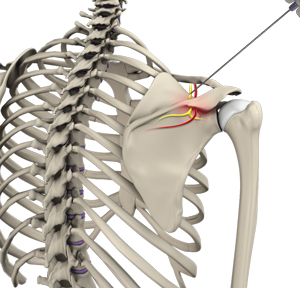
What is the Suprascapular nerve block?
A suprascapular nerve block is a procedure to inject an anesthetic or numbing medication along with a steroid (anti-inflammatory) in the region of the suprascapular nerve to stop the transmission of pain signals. The suprascapular nerve is formed by nerves arising from the spinal cord in your neck and provides sensation to the shoulder joint and the area over your shoulder blade or scapula. It transmits pain signals originating in these areas. A suprascapular nerve block works by interrupting these pain signals and preventing them from reaching the brain.
What are the Indications of the Suprascapular Nerve Block?
A suprascapular nerve block may be recommended for the treatment of:
- Acute pain from a shoulder injury
- Pain following shoulder surgery
- Adhesive capsulitis also called frozen shoulder
- Rotator cuff injuries
- Arthritis
- Bursitis
- and cancer pain
Prior to the Procedure
Before administering a suprascapular nerve block, your general health is reviewed. You should inform your doctor about any medical conditions or allergies as well as recent or current medications you are taking. You are advised to stop any blood thinning medication before your procedure.
How is the Suprascapular Nerve Block Procedure performed?
For the suprascapular nerve block, you will be seated or lying on your side. Sedation may be administered to keep you comfortable. The area over your shoulder blade is cleaned using an antiseptic solution. Your doctor will locate the suprascapular nerve using your anatomy. The suprascapular nerve passes through a bony notch at the top of the shoulder blade and is targeted at this region. A nerve stimulating needle is inserted to help locate the nerve. You will usually experience a tingling sensation or muscle twitch if the needle is inserted at the right spot. Ultrasound imaging may also be used to locate the suprascapular nerve. Once the nerve is located, local anesthetic with steroid medication is carefully injected via a needle. The needle is then withdrawn, and a band-aid is placed over the site. The procedure usually takes around 10 to 15 minutes.
Postoperative Care for the Suprascapular Nerve Block Procedure
Following the procedure, your shoulder will feel numb for a short time from the local anesthetic. The pain may return once the anesthetic wears off and you may feel soreness at the injection site.
The steroid can take up to 2 weeks to begin working and provide pain relief that can last a few weeks to a few months. Sometimes the medication does not provide any relief at all and will depend on the person.
- Avoid driving yourself home if you have received sedation for the procedure.
- Avoid straining the shoulder for at least 24 hours after your procedure.
- Any swelling at the site of injection may be treated by applying ice to the area.
What are the Risks and Complications of Suprascapular Nerve Block?
Although suprascapular nerve block is a relatively safe procedure, it may be associated with complications such as:
- Bleeding or infection at the injection site
- Nerve injury
- Pneumothorax
- Allergic reaction
